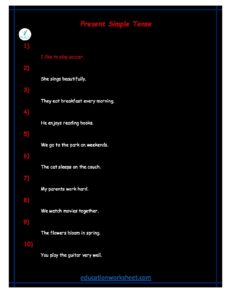how to converting Present Simple Tense interrogative sentences to positive form
how to converting Present Simple Tense interrogative sentences to positive form
Understanding the Present Simple Tense: Before delving into the transformation of interrogative sentences, it is crucial to have a solid grasp of the Present Simple tense. The Present Simple tense is used to talk about actions that happen regularly, facts, or general truths. It is characterized by its use of the base form of the verb (e.g., “play,” “eat,” “study”) and the addition of the third person singular “-s” in affirmative sentences when the subject is a singular noun or pronoun (e.g., “He plays football,” “She eats apples”).
Interrogative Sentences in Present Simple Tense

how to converting Present Simple Tense interrogative sentences to positive form
Interrogative sentences, also known as questions, are used to seek information or clarification. In the Present Simple tense, they often start with auxiliary verbs like “do” or “does” followed by the base form of the verb. Here are some examples of Present Simple tense interrogative sentences:
- Do you like chocolate?
- Does he study French?
- Do they play soccer?
Converting Interrogative Sentences to Positive Form: Converting interrogative sentences to positive form is a straightforward process that involves removing the auxiliary verb and reordering the words. Let’s break down the steps:
Step 1: Identify the Subject The first step is to identify the subject of the interrogative sentence. The subject is the person, thing, or entity performing the action in the sentence. In the examples above, the subjects are “you,” “he,” and “they.”
Step 2: Remove the Auxiliary Verb In interrogative sentences, auxiliary verbs like “do” and “does” are used to form the question. To convert the sentence to positive form, remove the auxiliary verb. For example:
- Original: Do you like chocolate?
- Positive Form: You like chocolate.
- Original: Does he study French?
- Positive Form: He studies French.
- Original: Do they play soccer?
- Positive Form: They play soccer.
Step 3: Reorder the Sentence In positive statements, the word order typically follows the subject-verb-object (SVO) pattern. This means that the subject comes first, followed by the verb and then the object (if applicable). Reorder the words accordingly:
- You like chocolate.
- He studies French.
- They play soccer.
how to converting Present Simple Tense interrogative sentences to positive form
Step 4: Check for Third Person Singular In the Present Simple tense, when the subject is in the third person singular form (he, she, it, or a singular noun), you should add the “-s” ending to the verb. For example:
- Original: Does she like ice cream?
- Positive Form: She likes ice cream.
- Original: Does it rain often?
- Positive Form: It rains often.
- Original: Does John play the guitar?
- Positive Form: John plays the guitar.
Common Mistakes to Avoid:
- Do not forget to remove the auxiliary verb (“do” or “does”) when converting interrogative sentences.
- Pay attention to the third person singular form and add the “-s” ending to the verb when necessary.
- Maintain proper subject-verb agreement.
- Be careful with subject pronouns (e.g., he, she, it, they) and use the correct form of the verb.
Examples with Different Subjects: Let’s explore more examples with different subjects to reinforce the concept:
- Original: Do we eat dinner at 6 PM? Positive Form: We eat dinner at 6 PM.
- Original: Does Mary like to read books? Positive Form: Mary likes to read books.
- Original: Do cats chase mice? Positive Form: Cats chase mice.
- Original: Does the sun rise in the east? Positive Form: The sun rises in the east.
how to converting Present Simple Tense interrogative sentences to positive form
Advanced Considerations: In some cases, converting interrogative sentences to positive form may involve more complex sentence structures or the use of modal verbs. Here are some advanced examples:
- Modal Verbs: Original: Can you swim? Positive Form: You can swim.
- Wh- Questions: Original: Where do they live? Positive Form: They live here.
- Embedded Questions: Original: Do you know what time it is? Positive Form: You know what time it is.
- Tag Questions: Original: You like ice cream, don’t you? Positive Form: You like ice cream.

Conclusion: Converting Present Simple tense interrogative sentences to positive form is a fundamental skill in English grammar. It involves identifying the subject, removing the auxiliary verb, reordering the sentence, and ensuring subject-verb agreement. By following these steps and practicing with various examples, you can confidently transform questions into positive statements, enhancing your overall understanding of the Present Simple tense and improving your English language skills. Remember to pay attention to special cases, such as third person singular subjects and the use of modal verbs or complex sentence structures, to master this essential aspect of English grammar.
how to converting Present Simple Tense interrogative sentences to positive form


